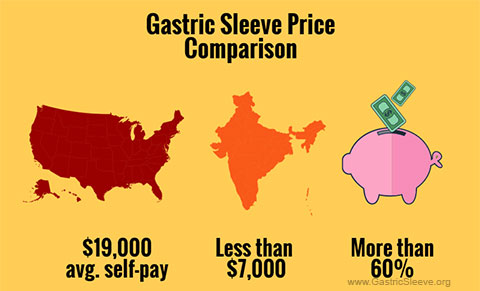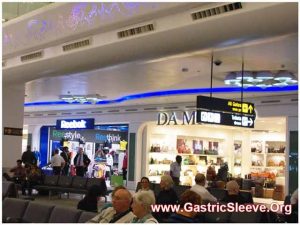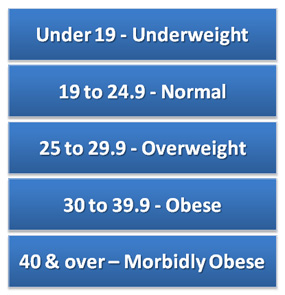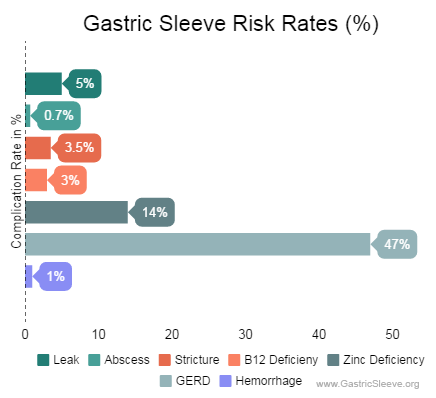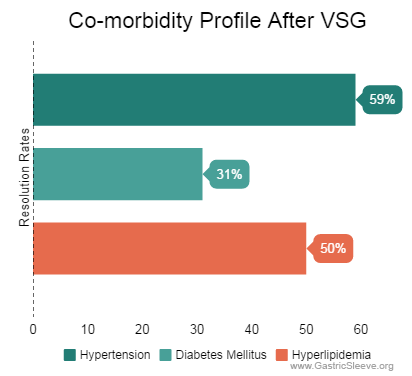Gastric Sleeve in New Delhi – India
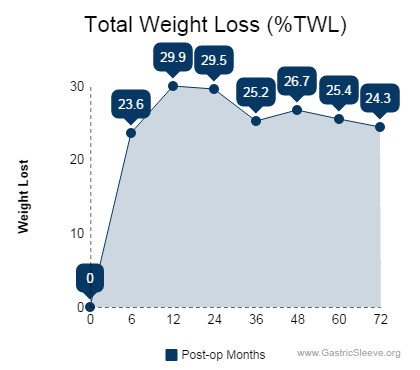 Our gastric sleeve bariatric surgery program in New Delhi, the national capital of India, is suitable for individuals who have failed to lose weight through conventional means and are seeking an affordable surgical solution outside their home country.
Our gastric sleeve bariatric surgery program in New Delhi, the national capital of India, is suitable for individuals who have failed to lose weight through conventional means and are seeking an affordable surgical solution outside their home country.
Vertical sleeve gastrectomy (VSG), more commonly known as gastric sleeve surgery, is a restrictive weight loss procedure that involves removal of nearly three-fourths of the stomach to limit its capacity to hold food.
This results in significant weight loss (refer to the figure on the right which shows total weight loss % up to 72 months after surgery).
How much for VSG in Delhi?
Less than $7,000
What’s Included in the Package?
- 3-night hospital stay in a single deluxe room
- Pre-op investigations
- Surgeon’s Fees
- Operation theater charges
- Anesthesia charges (for a detailed quote, contact us now through the quote-form on the right)
- Cash
- Credit card
- Wire transfers
Special Facilities for International Patients
To help you have a fulfilling gastric sleeve experience in New Delhi, India, we offer:
- Complimentary meals for one accompanying guest during hospital stay
- Sofa-cum-bed for accompanying guest
- Travel desk
- Translation services
- Assistance in finding post-discharge accommodation falling within your budget
Free Airport Transfers
We provide complimentary airport pick and drop services. The international airport is about 20 minutes from the hospital.
Complete Bariatric Experience
Quality Care at Full Service Hospital
Your bariatric surgery will be performed at a multi-specialty full service hospital certified by the National Accreditation Board for Hospitals & Healthcare (NABH).
Highly Experienced Bariatric Surgeon
Our competent team of surgeons, including a bariatric expert with experience of more than 12,000 laparoscopic procedures, works painstakingly to bring you the best possible care.
Here is a snapshot of our LEAD bariatric surgeon in India:
- Fellowship of International College of Surgeons – Chicago, USA
- More than 50 papers on bariatric and laparoscopic surgery presented at numerous national and international conferences
- Good global exposure, having attended conferences in the United States, Canada, the United Kingdom, other European countries as well as the Middle East
For more information on the weight loss surgeon, contact us through the website quote-form.
Effective Communication without any Language Barriers
English-speaking hospital staff and doctors ensure you have a good experience free from any linguistic impediments. We can also arrange for language interpreters, if required.
Patient Trust
We are a unit of US based BBB accredited company with more than 8 years of patient trust.
We have helped hundreds of individuals say goodbye to obesity with our comprehensive weight loss surgery programs. Here are some of our gastric sleeve client reviews. We will be glad to provide referrals, if requested.
How Long Will You Need to Stay for Surgery?
Time varies from case to case. The surgery itself takes anywhere between 1.5 to 3 hours followed by 2 to 5 days of hospitalization. Take these into account and your medical visit should take a minimum of seven days.
Quick Delhi Travel Guide
Entry Documents Required
- All foreign nationals are required to have a national passport with an Indian visa obtained from an Indian Mission/Port in their home country.
- They are required to apply for online Indian visa. Click here for more information.
- e-Tourist Visa facility has also been extended to nationals of some countries for short duration medical treatment (click here to check if you are eligible for one). This facility allows you to obtain travel authorization documents (to be presented to immigration authorities at select airports) on the click of a button. Additional conditions for an e-TV are:
- Passport should be valid for at least six months from the date of arriving in the country
- Travelers should have return/onward journey ticket with sufficient sums of money to be spent during their stay
- Travelers from Pakistan, Israel, Kenya, Ethiopia, Nigeria, Afghanistan and Somalia are required to have a valid polio vaccination certificate.
- Travelers from countries with risk of yellow fever transmission are required to have proper yellow fever vaccinations.
Delhi is served by its own airport – the Indira Gandhi International Airport. The city is well connected with other parts of the country by rail and road.
Best time to visit
October to March (marks the winter season; however, dense fog can interfere with flight schedules during the peak winters from late December to mid January).
Don’t get lost in translation
Some knowledge of the following basic phrases in Hindi (a widely spoken language in India) can be handy to get over language barriers when out on the street:
|
English |
Hindi |
|
Hello |
Namaste |
|
Goodbye |
Namaste |
|
Thank you |
Dhanyavad |
|
Can you help me? |
Kya aap meri madad karenge? |
|
How much is it? |
Yeh kitna ka hai? |
|
I don’t understand |
Mujhe samajh nahi aa raha |
|
I am lost |
Kho gaye hai |
|
Where is …? |
… kaha hai? |
What else can you do in the city apart from surgery?
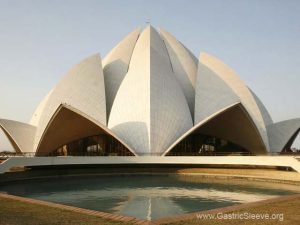 The national capital is a mish-mash of old world charm (in the form of architectural marvels dating back to the Mughal age) and modern day conveniences (as exemplified by the Metro rail). You may even include some leisurely sightseeing in your itinerary to get a little bit more out of your visit.
The national capital is a mish-mash of old world charm (in the form of architectural marvels dating back to the Mughal age) and modern day conveniences (as exemplified by the Metro rail). You may even include some leisurely sightseeing in your itinerary to get a little bit more out of your visit.
Some of the must-visits of the vibrant city are:
- Lotus Temple (Bahá’í House of Worship)
- Jama Masjid
- Akshardham Temple
- Hauz Khas Complex
- Lodi Gardens
- India Gate
- Jantar Mantar
- Qutub Minar
- Red Fort
- National Museum
General Travel and Safety Tips
- Steer clear of large gatherings to avoid being part of a stampede.
- Check for travel alerts and warnings issued by the US State Department.
- Possession of loose ammunition or weapons may carry detention/arrest.
- Narcotic drugs and psychotropic substances are illegal in the country.
- As of December 2015, legal drinking age in Delhi is 25 (legal drinking ages may vary from state to state throughout India)
- Photography may not be permitted at all public places (especially of deities in temples). You will find signboards restricting photography at such premises.
- You may be required to cover your head and remove footwear before entering most of the temples, mosques and other religious places.
- Do not drink tap water; always drink from bottles with intact seals.
- Do not eat raw or undercooked food.
- Use insect repellents and wear light colored clothing to prevent mosquito-borne diseases, such as dengue, malaria, and Japanese encephalitis.
- Important Emergency Numbers:
- Police Control Room: 100
- Ambulance: 102
- Fire: 101
- Women’s Helpline: 1091
Your Gastric Sleeve Guide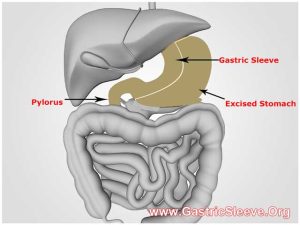
Who Qualifies for Sleeve Gastrectomy?
To be an ideal candidate for vertical sleeve, you must fulfill the following criteria:
- 18 to 65 years of age
- Body Mass Index:
- Either 35 or more (or you are overweight by more than 100 pounds), or
- Less than 35 with serious co-morbidities of obesity (such as diabetes mellitus, hypertension, sleep apnea, gastroesophageal reflux disease (GERD) and/or joint problems)
Body Mass Indicator
Calculate your BMI here.
What Happens During Surgery?
- After administering general anesthesia, the bariatric surgeon will make 4 to 5 tiny incisions in the abdomen.
- A laparoscope and special instruments for minimally invasive surgery will be inserted through these incisions.
- The laparoscope will be connected to a computer screen in the OT giving the surgeon an inside view of the abdominal cavity.
- The surgeon will remove almost 80% of the stomach along its greater curvature.
- The remaining portions will be sealed together with staple, thereby creating a “sleeve” or tube shaped pouch.
- No changes will be made to the pylorus (the sphincter muscles that allow food to enter or exit the stomach).
- After removing the scope and instruments, the surgeon will close the tiny incisions.
Alternative Names:
- Gastric resection
- Laparoscopic sleeve gastrectomy’
- LSG
- Gastrectomy – parietal
- Gastric reduction
When can You Return to Work after Surgery?
About two to three weeks after surgery (as recommended by the American Society for Metabolic and Bariatric Surgery (ASMBS)).
Risks and Complications
Some of the risks and side effects of sleeve gastrectomy are:
- Staple line leak
- Infection
- Blood clots
- Stomach obstruction
- Pouch stretching resulting in weight regain
- Vomiting and nausea
- Inflammation of the gastric lining
Compared to more complex procedures such as gastric bypass, gastric is a relatively safe procedure with lower complication rates and operative risks. Obesity Action Coalition pegs overall risk rates at 5-10%.
The following figure (based on a 2013 research study by Kourosh Sarkhosh et al.) shows its complication rates:
Positive Impact on Health
Weight Loss Outcomes
Average two year excess weight loss after VSG varies between 60 and 70%. In their 2012 research study, Lars Fischer et al. report no significant difference between excess weight loss after 2 years with gastric sleeve and bypass2
Refer to the figure given at the beginning of the page derived from a 2015 research study by Abelson et al. showing total weight loss (in percentage) over a period of 6 years.3
Resolution of Co-morbidities
Besides weight loss, gastric sleeve also results in resolution of some of the co-morbidities of obesity. Refer to the following figure based on a 2015 research study by Jonathan S. et al. showing resolution rates of co-morbidities in a group of 435 patients who underwent LSG from 2004 to 2013:
Do remember that gastric sleeve is no shortcut to weight loss. You will be required to make lifestyle changes and a serious commitment to living and eating well to see those pounds come off and maintain a healthy weight.
For more information on gastric sleeve in New Delhi, India, fill-out the estimate-request form on the right.
References:
- Sarkhosh, K., Birch, D. W., Sharma, A., & Karmali, S. (2013). Complications associated with laparoscopic sleeve gastrectomy for morbid obesity: a surgeon’s guide. Canadian Journal of Surgery, 56(5), 347–352. http://doi.org/10.1503/cjs.033511
- Fischer, L., Hildebrandt, C., Bruckner, T. et al, Excessive weight loss after sleeve gastrectomy: a systematic review. Obes Surg. 2012;22:721–731.
- Laparoscopic Sleeve Gastrectomy: Co-morbidity Profiles and Intermediate-Term Outcomes. Jonathan S. Abelson , Cheguevera Afaneh , Patrick Dolan, Genevevie Chartrand, Gregory Dakin, Alfons Pomp. J Obesity Surgery R 10.1007/s11695-015-2002-2. 2015-12-10 http://dx.doi.org/10.1007/s11695-015-2002-2

